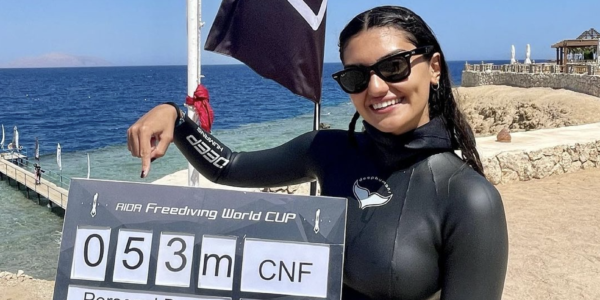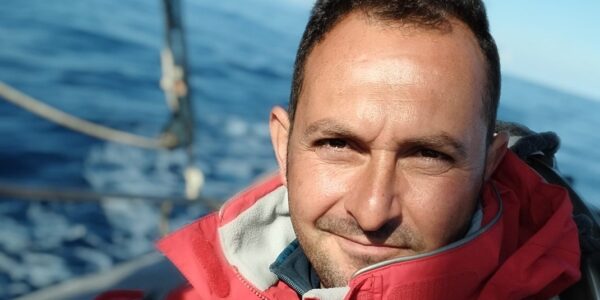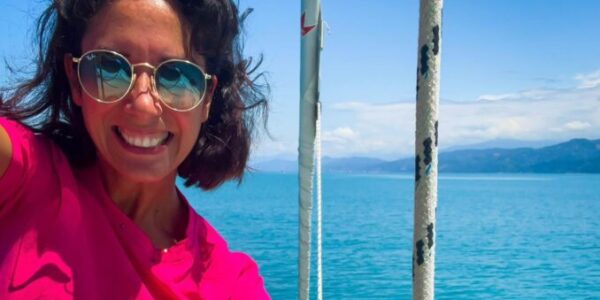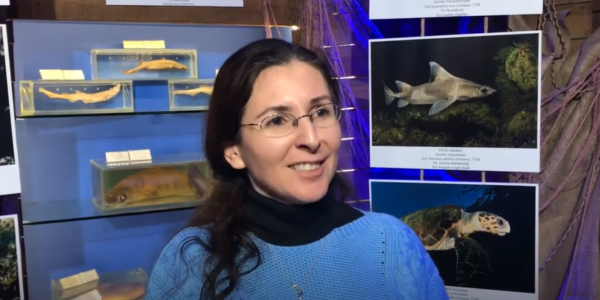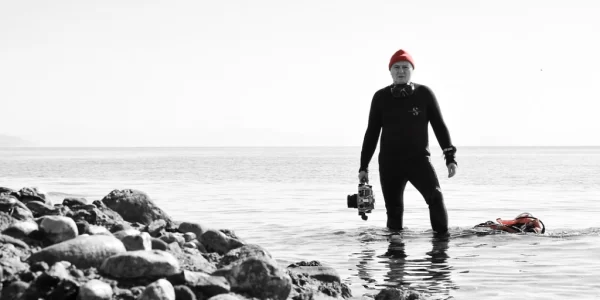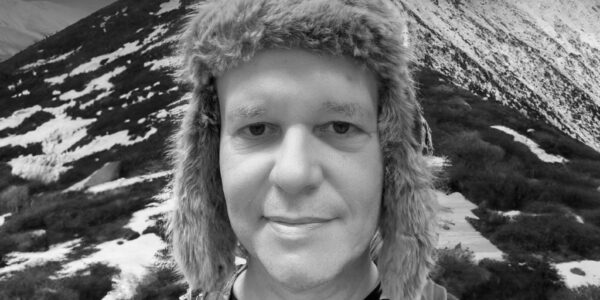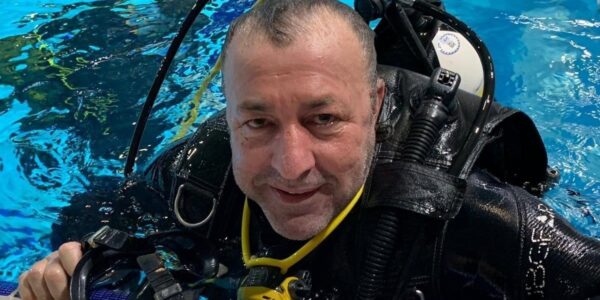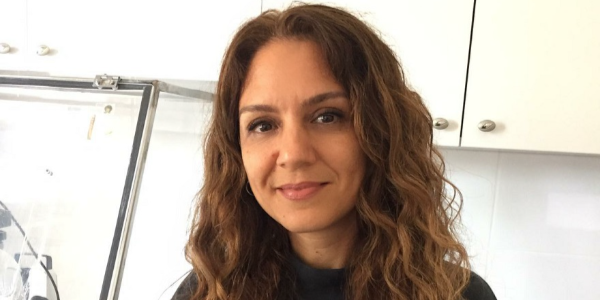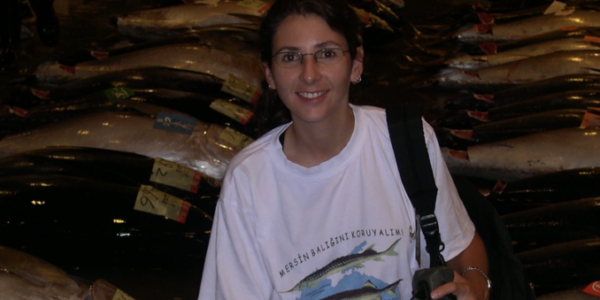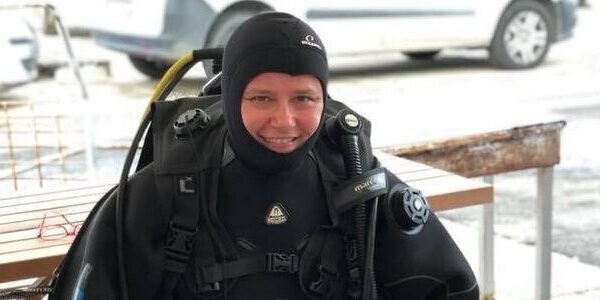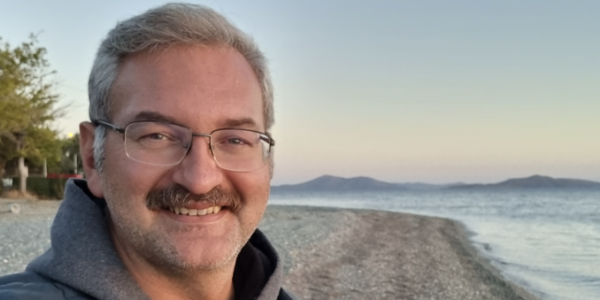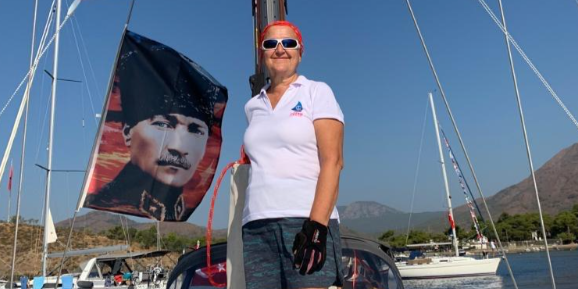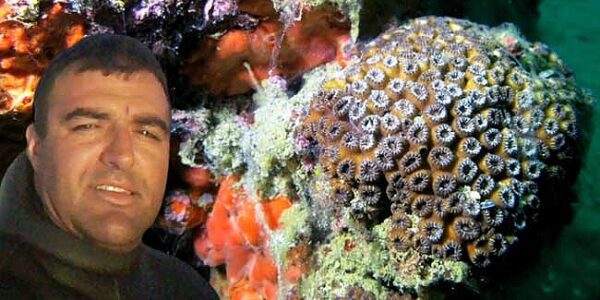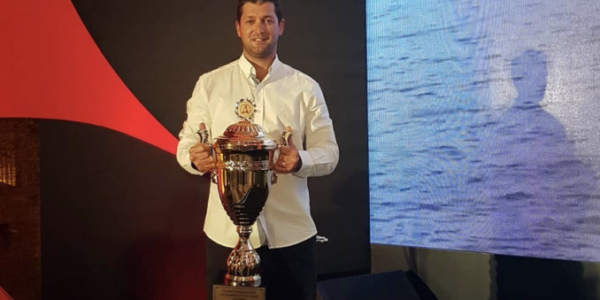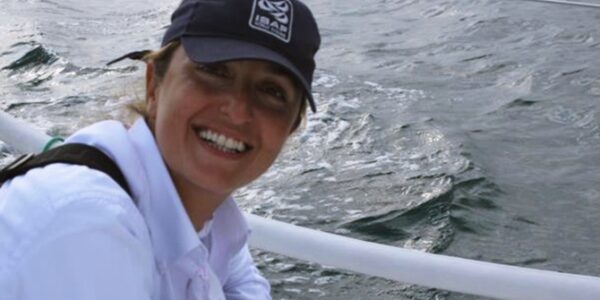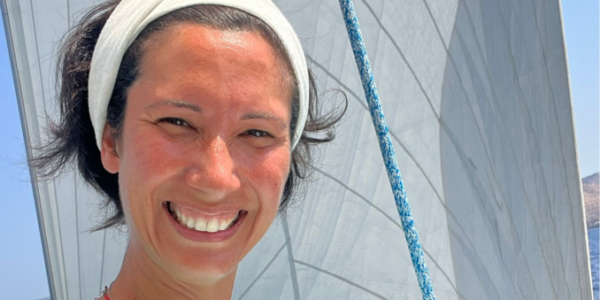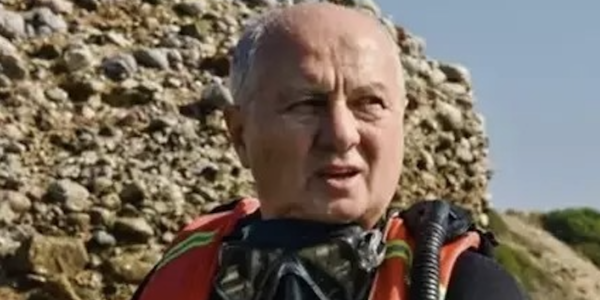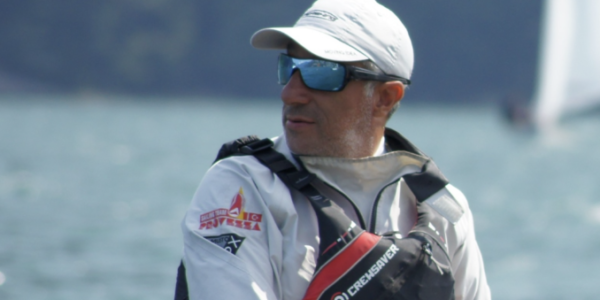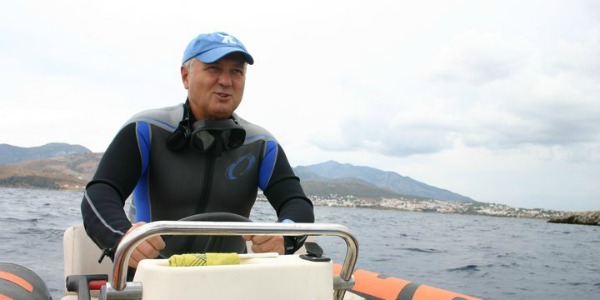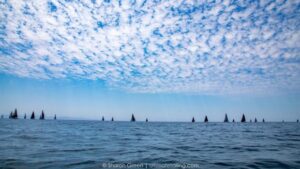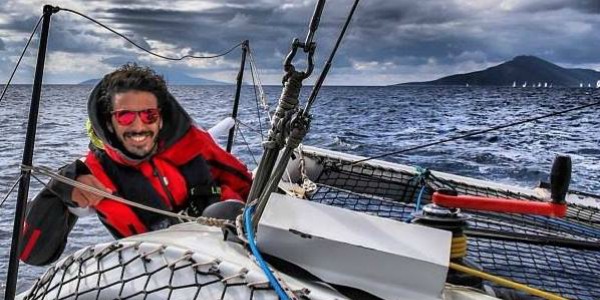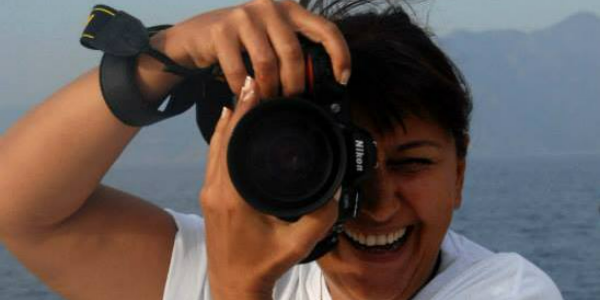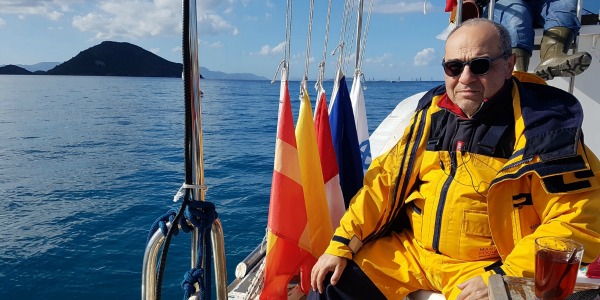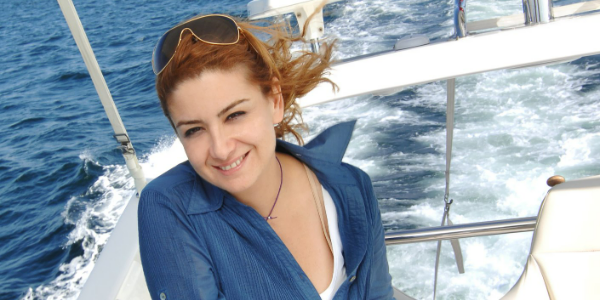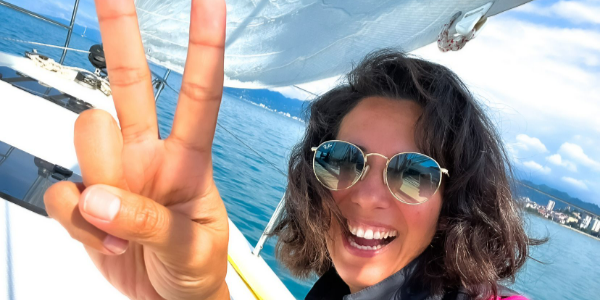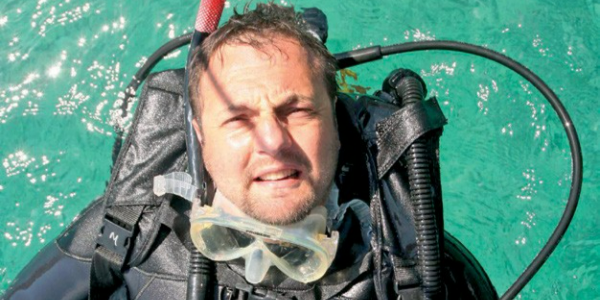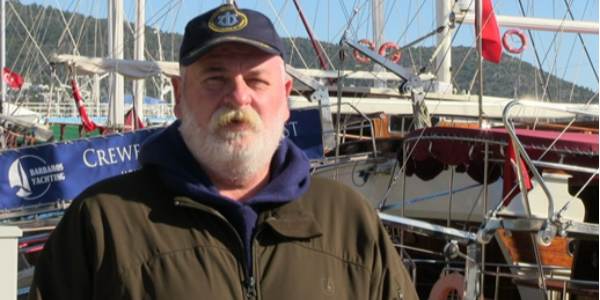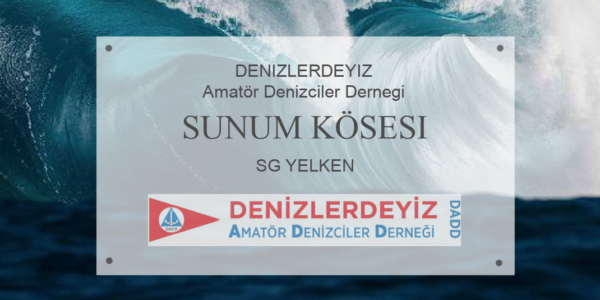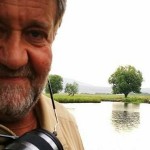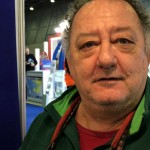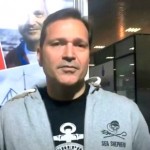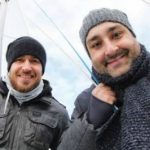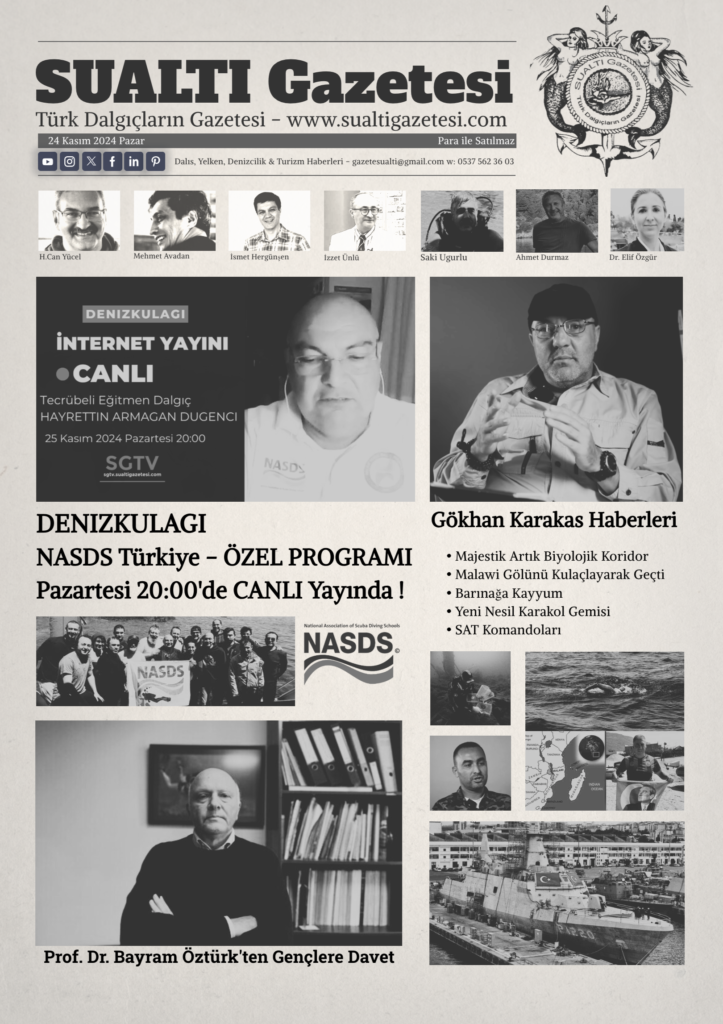A characteristic of Southern California racing is a noon start because the seabreeze takes a while to generate the onshore flow. While this makes for a good sleep after the Saturday night party, overnight racing can be a lottery.
The 49th Santa Barbara to King Harbor Race knows this reality all too well, and in this report by Zafar Khan, he shares the triumphs and torture from the 2022 edition onboard his 29-footer:
“We’re in that pesky 1-knot cyclone!” I hollered as we rounded the first rocks of Anacapa Island to port with our big “pink squid” spinnaker full of 18-knot wind — which suddenly transformed into a 1-knot wind swirl.
We spun around in the 1-knot cyclone trying to keep the kite filled as the wind went south, east, north, and then west, and around again in moments. The boat settled finally, and to our astonishment, we were becalmed, facing the opposite direction, directly staring into the whites of the eyes of the skippers of 20 yachts bearing down on us. Our bow, not our stern!
We were at the first “mark” of this famous course, which, as Jim Murrell, one of my crew, explained to me, is really four-races in one:
(1) The 25-mile “reach” race from Santa Barbara to Anacapa Island.
(2) Somehow surviving the one-knot cyclone that always seems to swirl in the back of Anacapa Island and exiting the island’s lee.
(3) Darting off to Point Dume across 40 miles of open sea as fast as possible through dusk before the wind shuts down.
(4) The mental game of traversing Santa Monica Bay through the night’s typically light air.
For us amateur racers, this four-in-one race requires mastery of the mental game as much as skilled yachtsmanship – as I now fully appreciate.
This was BeetleCat’s first start of this mega race, with 75 entrants of all sizes from 70-foot racing machines to 25-foot ultralights filtering in from across Southern California to the Santa Barbara Yacht Club for the famous Yacht Club evening BBQ in the sand where camaraderie of these veteran racers filled the air.
After 17 hours of motor-sailing north from King Harbor, BeetleCat arrived in Santa Barbara (with the engine alarm embarrassingly screaming for more oil!). Pre-race, the wind forecast was ominous – for a week it was predicted to be a no-wind drifter. There was a mental cloud of sailor’s dread hanging over the race — how long would a 5-knot to windless 80-mile downwind race take with the typical 2-4 knot head current?
Uncertainty aside, the docks in Santa Barbara were festive, and to everyone’s glee, all the racers awoke on race day to the astonishment of what seemed like a welcomed squall hitting the yacht club breakwater. The unexpected 14-knot morning wind created a raucous mood as crews across the marina grabbed ice and hastily rigged boats. Off to the start!
Each of the race boats paraded out of the Santa Barbara harbor on July 29 and circled for each class start across two side-by-side starting lines. By the time our start was called, that morning squall turned into a zephyr of less than 4 knots! Oh, that mental game…we on BeetleCat drifted across the starting line — just barely clearing the line before being disqualified for too late a start!
BeetleCat, with an off-wind PHRF rating for this race of 60, is a matte-black ultralight 29-foot Bravura B-29 sloop with a black flat top main and jib. Great in light air, but not great at drifting.
The Risk-Mental Game of “Leg 1” to Anacapa.
As the wind shifted from the south to southwest, the wind gradually built and we threw up our Code Zero spinnaker, as planned, with what seemed like a perfect 25-mile rum-line to the west end of Anacapa, our rounding point.
After about an hour, we could see the island and the fleet separating into two packs, those boats that chose to sail the shortest distance (us and others) to the island rounding point, and those that seemed like they were lost, heading to the middle or east end of the island. Strange!
Adrian Velazquez, one of our crew visiting from Costa Rica was so confused, he blurted out, “I didn’t know we could choose which side of the island to round!” We, of course, corrected him and said all those boats were simply heading for rocks and seemed to be crazy.
After some debating the optimal course and sails, we saw something magical happen to the big boats way ahead that seemed to have been heading for rocks on the east end of the island; they appeared to have been impossibly lifted upwind with their downwind sails, from the east end of the island around the island’s west end. Weird!
We decided to join those who had appeared to be heading on an impossible course, arguably too late in the leg, and swapped out our Code Zero for our biggest pink A2 spinnaker. With lots of mental anguish, we headed down and pointed to the center of the island like the others, to the big rocky cliffs in the middle if Anacapa Island.
And then the magic sputtered. We’re not really sure why, but as we approached the island, the wind built to 18-knots (good) and the 133-degree true off wind angle that we needed to skirt the island (for us to not hit the island) was quite tight (bad) — we were on the verge of continuous roundups. It was almost too tight for us with this spinnaker.
And then, appearing behind our spinnaker out of nowhere was a massive oil tanker on a collision course with us (worse). Well, maybe some magic happened. We somehow skirted the bow of the tanker, nearly close enough to get the infamous five horn fine and surf its bow wave, and spun around the west end of Anacapa without hitting any rocks.
We realized, success on this leg was all about taking risk; which we did (we passed some boats in the maneuver) but not enough risk to be with the leaders, those who headed to what had “appeared” to be the wrong end of the island from the start.
The Bewilderment-Mental Game of “Leg 2” Across the Backside of Anacapa.
‘Where is the wind coming from?’, I thought as we careened around the west end of the island. “Head up, no head down, wind is coming from the south, no, the north, no its not, it’s from the west, pull in the spinnaker, no, ease the sheets, no, drop the spinnaker…” shouted Jim, our most experienced crew, a 15-race veteran and champion J-boat racer.
“We’re in that pesky 1-knot cyclone!!” I hollered! We went from an adrenaline filled 18-knot spinnaker reach to a 1-knot wind swirl in seconds, and as we were trying to keep the kite filled, we realized too late that we were absolutely motionless (yes, 0 knots) and worse, stuck pointing in the opposite direction, directly at all of the oncoming boats!
What a spectacle we must have been — we were sitting ducks, staring at all the other crews zipping by us. But, one by one, they all got caught up in this same bewildering (no-)wind swirl.
The mental game here was how to get out of the lee of the island, as fast as possible, and by some stroke of luck and expert spinnaker trimming by crew Adrian, our spinnaker caught the tail wind coming off a bypassing boat, filled and sucked us out of the strange no-wind vortex.
We were back on our way and looked up with wonder as we were within spitting distance (a quarter mile spit) of three other boats in our class, Wolfhound, Double Down, and No Compromise. Flying Dutchman was up ahead – they were leaders of the risk-takers and their added risk seemed to have paid off for them.
So the four of us were now spinnaker jibing back and forth, working to exit the lee of Anacapa, and were all soon on our way towards Point Dume.
The Anxious-Mental Game of “Leg 3” from Anacapa to Point Dume.
This is the most beautiful leg of the course. Perfect 75-degree Southern California blue skies, sun setting over the Channel Islands to the stern, occasional dolphin playing in our bow wave, big pink spinnaker up, surfing the waves… it was 40 miles of epic offwind sailing. Southern California racing at its finest (in my humble opinion). So, why anxious?
This leg is all about trying to ride the last puffs of west wind before it was predicted to simply “shut off”. Somehow it seems like we were the last boat the wind gods let into the final breeze of the day. We had 15 knots of sustained wind for 40 miles, but we could see the boats just off our stern disappearing in the distance; the wind door slammed right behind us; and I mean, RIGHT behind us.
As we approached Point Dume, and the wind started to drop, our anxiety heightened; we jibed back and forth, essentially testing the width of the remaining breeze in our now private wind funnel. When would the wind stop? How long could we carry our current 8 knot boat speed? It looked as if Lawrence, our bowman, was challenging the wind gods to a game of chicken, and so far, he was winning!
The sun set, and through the night Lawrence was working his wind-god magic and we (quite thankfully) kept our 7-8 knot pace. (We heard after the race, the skipper of the sleek 40-foot Marezia tempted the wind gods toasting with shots of rum, to no avail. The wind gods stubbornly would not open the door to our private wind funnel for many yachts).
We were out in the middle of nowhere, miles ahead of half the fleet that got shut out of the wind to Point Dume, and miles behind the risk takers that had the perfect first-leg Anacapa strategy. The only boat in sight out was the powerful 50-foot Jeanneau Scarlet Fever with its massive white and red spinnaker.
Lawrence’s wind-god dance ended. Then, silence. The wind stopped. Our speed was zero. The ocean was so glassy, we were almost lured into jumping off the back for a refreshing night swim.
The Mental-Dilemma of “Leg 4” from Point Dume to the King Harbor Finish.
It was 11pm, pitch dark, not a boat in sight, the glassy ocean without any wind ripples, not even a puff of wind. Our spinnaker, like a colorful magician’s handkerchief pinched at the masthead, annoyingly simply hung limp.
We tried many things over an hour, with varying sail combinations, working to suck as much wind out of each puff and convert its energy into speed (or at least into forward movement). While we are a light wind boat, we are not a no wind boat, unfortunately.
By midnight, we progressed at 1 knot/hour (of current) and had 15 miles left to go, along the rumb line to King Harbor. We were approximately 8 miles southwest of the Santa Monica Pier and 5 miles south of Malibu.
As background, I’ve been yacht racing for one year now, and somehow got addicted to the adrenaline-fill of singlehanded offshore racing with a group of Pacific Singlehanded Sailing Association (PSSA) sailing enthusiasts.
With my inexperience, I really don’t leave the dock thinking I am going to win; sure, I leave the dock looking to compete to the best of my abilities (and luck or lack of), but the real enjoyment is the self-challenge of surviving each back-yard adventure that yacht racing makes accessible out here in Los Angeles.
It’s like entering a marathon with Olympic runners. You’re looking to do your personal best, and work through the mental anguish and physical challenge to get to the finish line. This is the “PSSA” racer mentality (at least the mentally of those who like me are not winning the PSSA races but get out there and endure).
So by midnight, we’ve been bobbing for an hour. Every forecast shows no wind until mid-morning (9 hours from now); if we continued, we expect we would sail the next 15 miles over the course of 8 hours or more.
While we could have endured, in the mental fog of the race and contrary to my PSSA-ethos, we made the decision to elegantly withdraw, and motor back. I am not really sure why we withdrew at that point. After all, BeetleCat only motors at 4 knots – it still took us nearly 4 hours to arrive in King Harbor.
By contrast and exemplifying the PSSA-ethos of sailing endurance, David Bew’s J/100 Kanani, a legendary PSSA racer, sent us a note at 11am, now 23 hours after the start: “We’re still 11 miles west of King Harbor” (meaning, far out to sea) “maybe 4 more hours.”
And, his Japanese crewmember and new PSSA racer added, “Engines blow,” (not “blow up” like what happened to Jerome Sammarcelli’S Columbia 32C during the delivery to Santa Barbara) “Japanese don’t quit,” he added like a samurai.
While this year, BeetleCat’s first SB2KH race, we gracefully withdrew at midnight after racing 66 miles of the 81 miles needed, 15 miles from the finish line; perhaps next year the PSSA-blood in me will inspire us to endure all pain and finish.
We arrived back at the King Harbor Yacht Club at 4am, saw the yacht club crew tirelessly helping boats find slips and score results in real time; and gobbled up some aged hot dogs that were left over for the finishing racers; then returned a few hours later for the King Harbor Yacht Club race finish extravaganza.
Congratulations to all the winners; all those who won, those endurance racers who sailed across the finish line at whatever time – all 50 of you. And, hats off to the 20+ other competitors who dealt with the mental dilemma of whether to continue or gracefully withdraw; who gave it their all, over 12 hours of adrenaline-filled yacht-racing, and ultimately quit.
Post-race, King Harbor Yacht Club prepared a shrimp fest on the patio to celebrate all racers – those who finished and those who did not. For the BeetleCat crew, it was the just-needed medicine to calm the angst around our decision to leave the race.
Denny Browne, skipper of the Beneteau 10R Renegade who ultimately withdrew somewhere out in the Pacific, reflected on the day: “What an adventure!”
I think those three words best tell the story for all.
Source: scuttlebutt – https://www.sailingscuttlebutt.com/2022/08/24/going-offshore-for-the-adventure/
